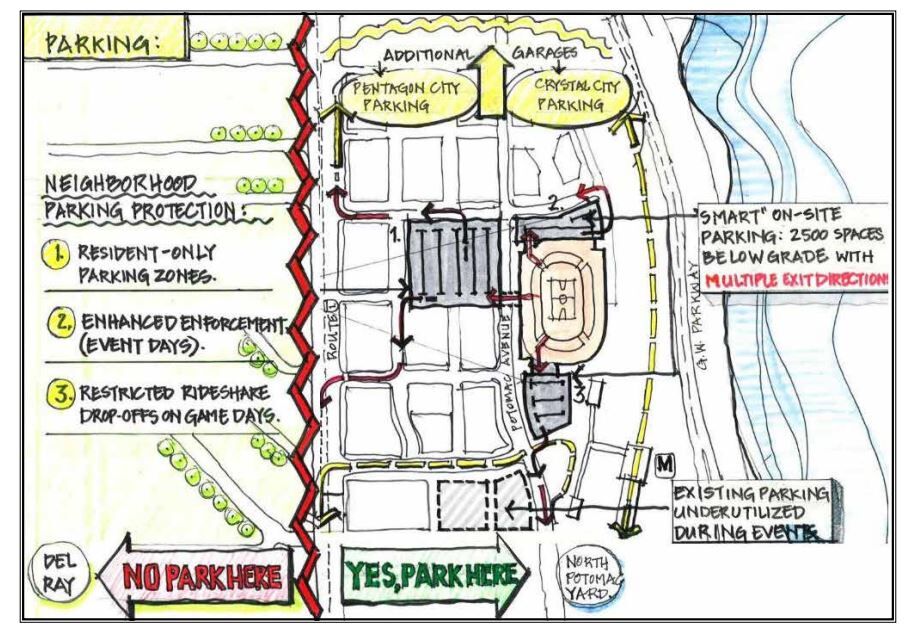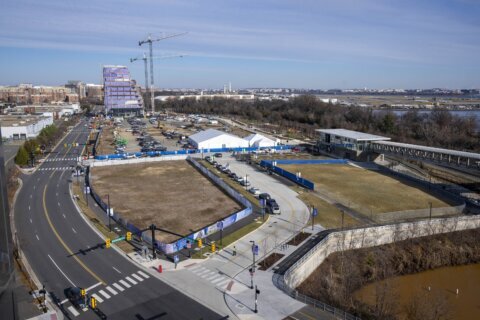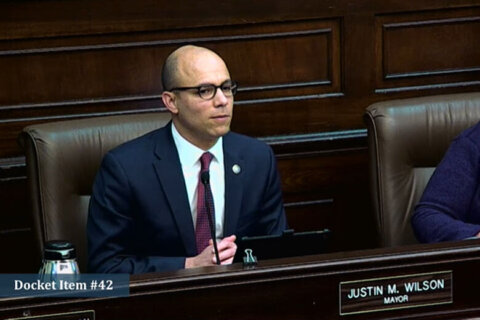The Commonwealth of Virginia, City of Alexandria and Monumental Sports & Entertainment officials unveiled an overview of its plans Thursday for a new sports arena and entertainment district in Potomac Yard.
The plan includes 9 million square feet for an arena that would house the Washington Capitals and Wizards teams as well as an entertainment district that includes a separate 3,000-seat venue for concerts, a large underground parking lot and much more.

In a release, Virginia Secretary of Transportation Sheppard “Shep” Miller III said that a study conducted by transportation experts at Kimley-Horn, an engineering and design consulting firm, showed encouraging results that would give them “a clear path forward.” He added that the Commonwealth of Virginia will continue to work with the city of Alexandria to “create a successful multimodal plan that delivers the kind of game day experience that guests want.”
The study also found that significant focus would have to be put on minimizing impact during peak traffic during rush hours when there are home games, as well as allocating millions into improvements into the surrounding roadways like Route 1. It also recommended new strategies that would focus on “non-auto mode share” — Metro rail, bus service, pedestrian and bicycling — infrastructure and access.
For protecting nearby neighborhoods, strategies include off-site ride-sharing zones and expanding trails for bikes and pedestrians as well as self-storage for cyclists. There are even notes about possible water taxis in the future.
- What impact could bringing Capitals, Wizards to Northern Va. have on taxpayers?
- Alexandria leaders make case to residents for a monumental move
- Slam dunk or calling foul? Alexandria residents react to proposed Capitals, Wizards move
- Mayor Bowser on Capitals and Wizards leaving DC: ‘Downtown is going to be just fine’
The planned site for the new arena has gotten a lot of pushback from residents who have voiced their concerns about the possible rise in taxes to fund the project.
In an interview with WTOP last month, Alexandria Mayor Justin Wilson said only 5% of the total cost of the project — about $100 million — will come from Alexandrians’ taxes.
“It’s a model that minimizes the risk on the taxpayers, both the state and the city, and helps drive economic growth in Potomac Yard, which is ultimately what we’re trying to do,” Wilson said.
Another concern among residents is the uptick in traffic in an otherwise suburban area in transition on its roadways and Metro routes.
The new arena would sit off Potomac Avenue, next door to Metro’s newest station, Potomac Yard, and a block from Route 1.
“The transportation plan unveiled at last night’s listening session only confirmed that this project lacks adequate planning and is grossly underprepared to move forward,” the Stop the Arena Coalition said in a statement. “The most significant arterial routes of the city – north south – will become clogged by parking, noise, congestion and air pollution, spilling over into many externalities and higher costs for the community.”
“Transportation is probably the No. 1 quality of life concern that I’ve heard about from the residents (who) have written to me, and it will be really key to me and making my final decision,” state Sen. Adam Ebbin said in a virtual town hall with the Del Ray Citizens Association about Metro’s recent budget shortfalls in January.
Residents are also concerned about the traffic and lack of metro stops by the prospective stadium. Metro General Manager Randy Clarke has said that the Potomac Yard Metro would require a major changes to accommodate the increased foot traffic by the stadium.
Three lines get you to the Gallery Place-Chinatown stop outside the Capital One Arena in downtown D.C. and there are five other stops in walking distance, while there are only two lines that metro riders can use to get to the one stop by Potomac Yards.
“The news of major development is almost always followed by a fear of the unknown and change; National Harbor, the Wharf and now Potomac Yard. Those concerns aren’t baseless — traffic is worse along Maine Avenue during events,” said WTOP Traffic Reporter Dave Dildine.
Dildine said that the new outline of the arena still has some “unknowns” in terms of how it will accommodate impacted residents when construction starts.
“More than half of the pregame approaches are expected to be southbound on Route 1. The idea of turn lanes separating game traffic from commuters is pie in the sky. If there’s an opportunity to be cut off, someone will take it,” Dildine said.
“The goal is to maximize every iota of throughput from all modes. Transportation planners don’t focus on moving more cars, trains and buses; the focus is on moving more people and in the most efficient way possible,” he said.
WTOP’s Neal Augenstein contributed to this report.
Get breaking news and daily headlines delivered to your email inbox by signing up here.
© 2024 WTOP. All Rights Reserved. This website is not intended for users located within the European Economic Area.








